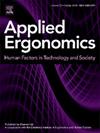Threats to performing high-risk resident care activities in nursing homes: A work system analysis
IF 3.4
2区 工程技术
Q2 ENGINEERING, INDUSTRIAL
引用次数: 0
Abstract
Infections from multidrug-resistant organisms (MDROs) are a major concern for nursing home (NH) resident morbidity and mortality. Our goal was to identify threats to healthcare workers (HCWs) safely and efficiently performing resident care activities that contribute to MDRO transmission in NHs. Following focus group discussions with certified nursing assistants, we identified threats in terms of the Systems Engineering Initiative for Patient Safety work system model and then induced 24 broader themes. We then used Fuzzy Cognitive Mapping (FCM) to characterize how themes influence one another. FCM revealed two prominent themes that increase the amount of physical contact (transmission) between HCWs and residents and promote lapses in preventative practices during high-risk activities: 1) additional steps or tasks arising during these activities and 2) when these activities become otherwise prolonged. These themes were driven by themes related to the organization, residents, and residents’ caregivers. To reduce MDRO transmission from these activities, the work systems of NHs must better support the capabilities, limitations, needs, and preferences of both the HCWs providing and the residents receiving care.
在养老院进行高风险居民护理活动的威胁:工作系统分析
耐多药生物感染是疗养院居民发病率和死亡率的主要问题。我们的目标是确定对卫生保健工作者(HCWs)安全有效地进行住院护理活动的威胁,这些活动有助于在NHs中传播MDRO。在与认证护理助理进行焦点小组讨论后,我们根据患者安全工作系统模型的系统工程倡议确定了威胁,然后引出了24个更广泛的主题。然后,我们使用模糊认知映射(FCM)来描述主题如何相互影响。FCM揭示了两个突出的主题,增加了卫生保健工作者和居民之间的身体接触(传播),并在高风险活动期间导致预防措施的缺失:1)在这些活动期间出现的额外步骤或任务,以及2)当这些活动以其他方式延长时。这些主题是由与组织、住院医生和住院医生护理人员相关的主题驱动的。为了减少这些活动造成的MDRO传播,NHs的工作系统必须更好地支持提供护理的卫生保健工作者和接受护理的居民的能力、局限性、需求和偏好。
本文章由计算机程序翻译,如有差异,请以英文原文为准。
求助全文
约1分钟内获得全文
求助全文
来源期刊

Applied Ergonomics
工程技术-工程:工业
CiteScore
7.50
自引率
9.40%
发文量
248
审稿时长
53 days
期刊介绍:
Applied Ergonomics is aimed at ergonomists and all those interested in applying ergonomics/human factors in the design, planning and management of technical and social systems at work or leisure. Readership is truly international with subscribers in over 50 countries. Professionals for whom Applied Ergonomics is of interest include: ergonomists, designers, industrial engineers, health and safety specialists, systems engineers, design engineers, organizational psychologists, occupational health specialists and human-computer interaction specialists.
 求助内容:
求助内容: 应助结果提醒方式:
应助结果提醒方式:


